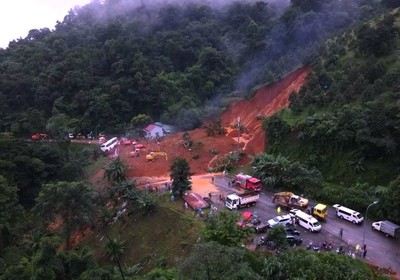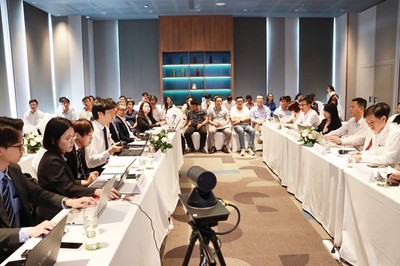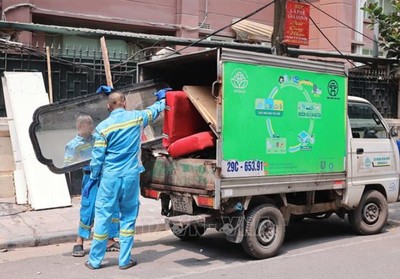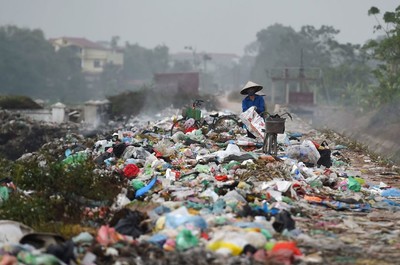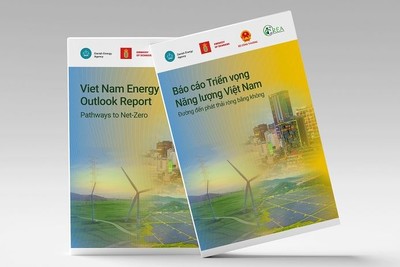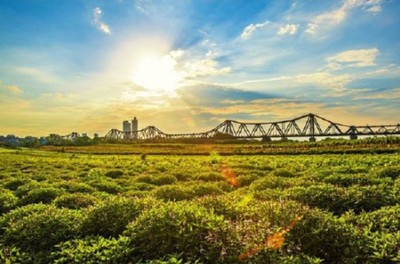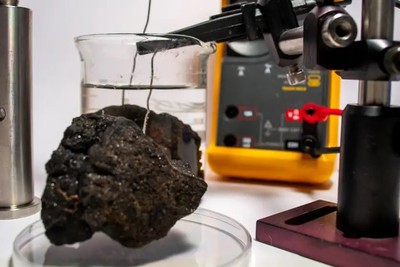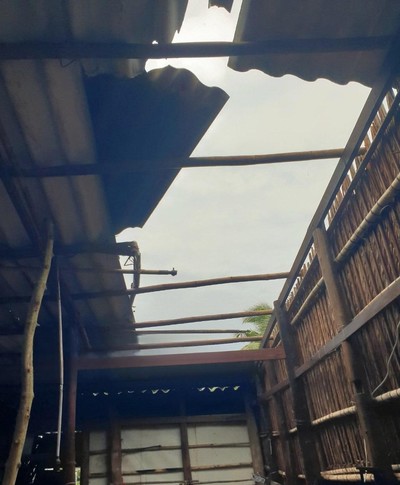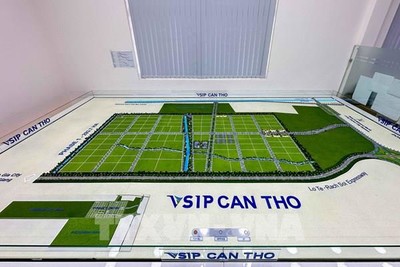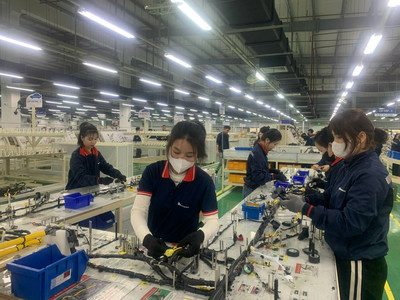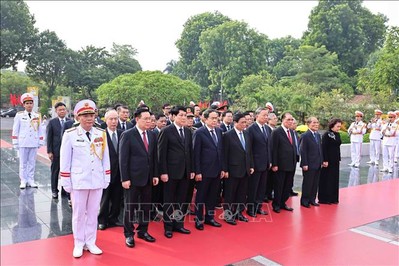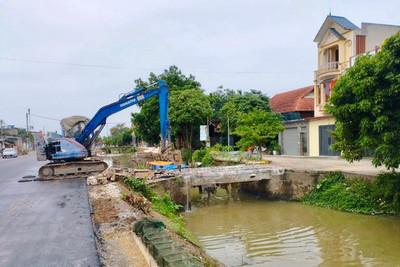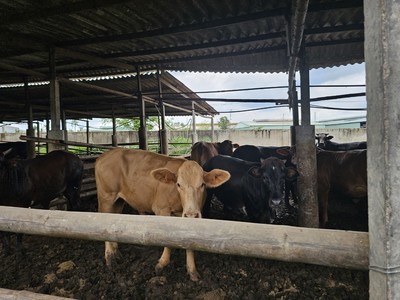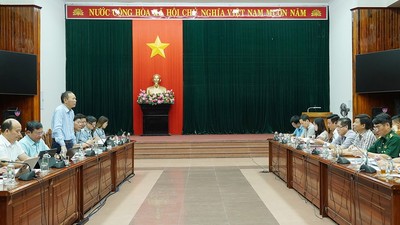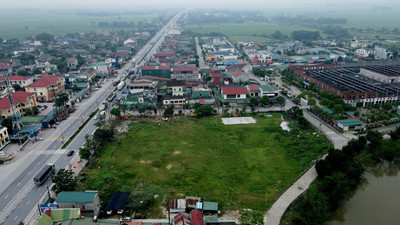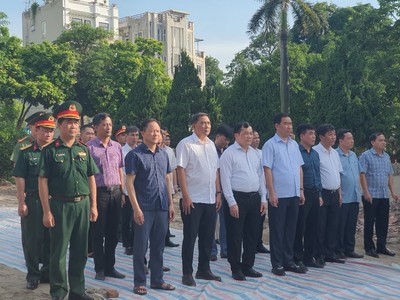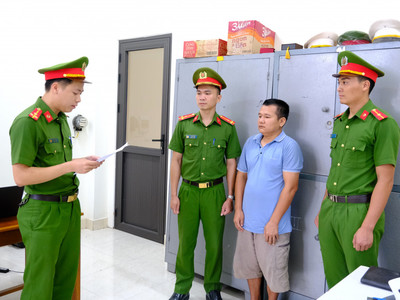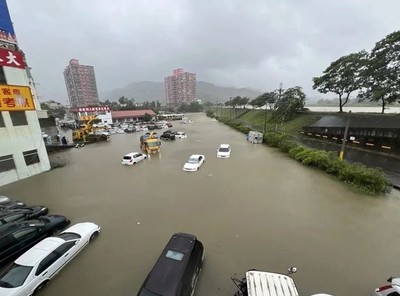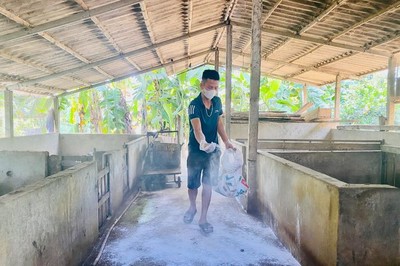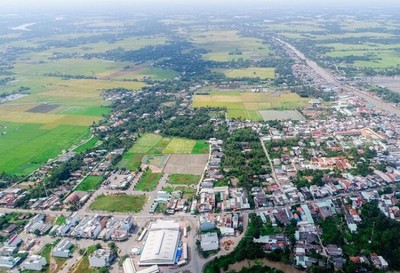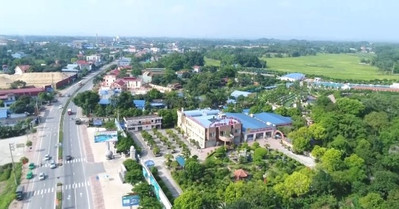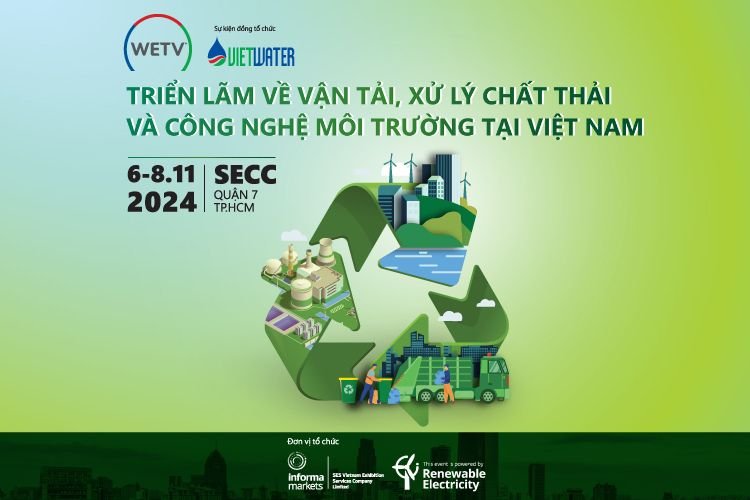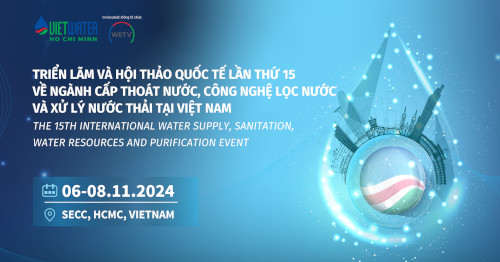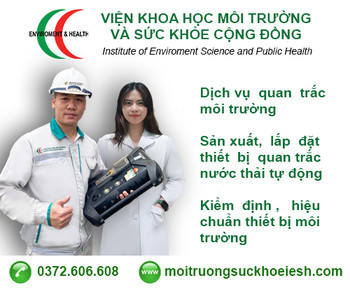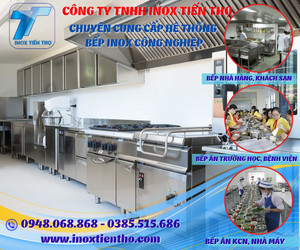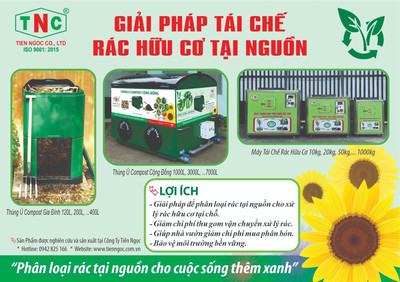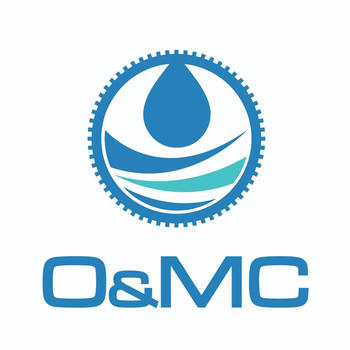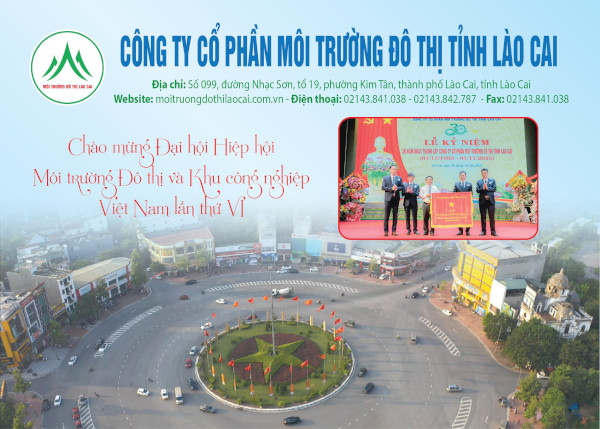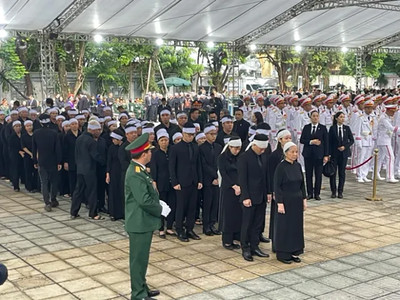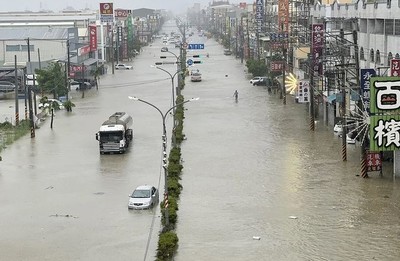Công bố quốc tế lĩnh vực môi trường số 07-2024
Ban biên tập Chuyên trang Quản lý Môi trường, Tạp chí Môi trường và Đô thị Việt Nam trân trọng giới thiệu tới quý độc giả Công bố quốc tế lĩnh vực môi trường số 07-2024.
Về quản lý môi trường
- Sự biến đổi không gian theo thời gian của carbon hữu cơ trong sông suối ở băng quyển Bắc bán cầu.
- Làm sáng tỏ tác động của sự lãnh đạo lấy sinh thái làm trung tâm và các hành vi ủng hộ môi trường trong các tổ chức chăm sóc sức khỏe: Vai trò của ý thức xanh.
- Những tiến bộ, thách thức và đề xuất gần đây về các phương pháp giảm phát thải SF6.
- Khám phá mối quan hệ giữa sự tham gia của du lịch, trao quyền cho người dân, chất lượng cuộc sống và sự hỗ trợ của họ để phát triển du lịch bền vững.
- Xem xét lại vai trò của CNTT và quản trị thể chế xanh đối với sự bền vững môi trường và đề xuất lộ trình giảm thiểu dấu chân sinh thái bằng mô hình định hướng biến động.
- Phương pháp phân bổ trách nhiệm carbon với cơ chế khuyến khích dựa trên lượng khí thải carbon và tính toán bù đắp carbon.
- Đánh giá và đánh giá toàn diện các phương pháp và công nghệ thu giữ carbon: Một nghiên cứu về môi trường.
- Nghiên cứu ảnh hưởng của các điều kiện kinh tế xã hội, năng lượng tái tạo và đổi mới sinh thái đến suy thoái môi trường ở Hoa Kỳ: Phân tích dựa trên lượng tử wavelet.
- Các mô hình không gian thời gian và tác động khí hậu của động lực carbon ở các khu vực phát triển kinh tế của Trung Quốc trong 40 năm qua: Trường hợp của tỉnh Giang Tô.
Về môi trường đô thị
- Tập thể dục khi nào và ở đâu: Đánh giá mức độ phơi nhiễm cá nhân với các chất ô nhiễm trong không khí xung quanh vùng nhiệt đới đô thị ở Singapore.
- Ô nhiễm không khí tại các thành phố lớn của Ba Lan trong giai đoạn 2005–2021: Cường độ, tác động và nỗ lực giảm thiểu.
- Xe điện giúp cải thiện chất lượng không khí đô thị như thế nào: Một nghiên cứu ở Vũ Hán.
- Ảnh hưởng của độ axit sol khí và phối tử hữu cơ đến độ hòa tan kim loại chuyển tiếp và khả năng oxy hóa của vật chất hạt mịn trong môi trường đô thị.
- Ý nghĩa sức khỏe của các kịch bản chính sách tán cây đô thị ở Denver và Phoenix: Đánh giá tác động sức khỏe định lượng.
- Phân tích tác động và dự báo xác suất (EAPF) của quản lý thời gian thực đối với ngập lụt đô thị: Khung xác minh hai chiều mới.
- Tối ưu hóa bể phản ứng màng sinh học di chuyển để xử lý nước thải đô thị.
- Loại bỏ SARS-CoV-2 trong các nhà máy xử lý nước thải đô thị: Tập trung vào bùn hoạt tính thông thường, lò phản ứng sinh học màng và phân hủy kỵ khí.
- Tác động của thay đổi nhân khẩu học đến dấu chân sinh thái: Nghiên cứu ba bên về đô thị hóa, dân số già và công nghệ giảm thiểu môi trường.
Về môi trường khu công nghiệp
- Định lượng sự đóng góp của các khu công nghiệp vào đảo nhiệt đô thị: Sự liên quan và tác động trực tiếp.
- Làm thế nào để chọn phương pháp xử lý cấp ba tốt nhất cho nước thải giấy và bột giấy? Đánh giá vòng đời và phân tích kinh tế là công cụ hướng dẫn.
- Giá trị bằng sáng chế của công nghệ xanh có ảnh hưởng đến việc chuyển giao nó không? Vai trò điều tiết cạnh tranh trong ngành.
- Đa hướng có tốt hơn không? Nghiên cứu tác động của việc kết hợp quản lý môi trường ở các thành phố khai thác mỏ.
- Dự đoán lượng phát thải ô nhiễm không khí của ngành công nghiệp đúc: Dựa trên dữ liệu lớn về điện.
- Công nghiệp hóa tái chế chất thải dệt may vòng hở và khép kín theo hướng bền vững: Đánh giá.
- Định hướng trong các sứ mệnh chính sách mang tính chuyển đổi: Trường hợp đạt được mức phát thải ròng bằng 0 trong ngành công nghiệp chế biến của Thụy Điển.
- Quá trình khử cacbon của ngành công nghiệp sưởi ấm trung tâm ảnh hưởng đến việc làm như thế nào? Phân tích không gian thời gian từ góc độ đô thị hóa.
- Thu hồi nhiệt thải hiệu quả từ vật liệu dạng hạt kết dính công nghiệp: Bộ trao đổi nhiệt gián tiếp giường chuyển động với khả năng kiểm soát dòng chảy đặc biệt.

Xin trân trọng giới thiệu!
ENVIRONMENTAL MANAGEMENT / QUẢN LÝ MÔI TRƯỜNG
1. Spatiotemporal variability of organic carbon in streams and rivers of the Northern Hemisphere cryosphere
Science of The Total Environment, Volume 906, 1 January 2024, 167370
Abstract
The earth's cryosphere is the outpost of climatic warming, which leads to rapid changes of organic carbon (OC) transport from terrestrial to aquatic ecosystems. OC in the cryosphere rivers plays vital roles in the carbon cycle and river ecosystem health. Yet, we still lack a comprehensive assessment of the spatiotemporal patterns of riverine OC across the Northern Hemisphere cryosphere. Here, we compiled OC concentration, radiocarbon (14C), and the specific ultraviolet absorbance (SUVA) of dissolved OC (DOC) at 254 nm data from 1007 unique sites, extracted from 138 published literature between 1972 and 2022. Overall, the average DOC and particulate OC (POC) concentrations are 6.34 and 2.61 mg C L−1, respectively, with the average age of DOC and POC being ~1100 and ~4300 years BP, respectively, indicating the release of aged carbon pools. Seasonal variations in DOC and POC concentrations, Δ14C-DOC and SUVA254 were observed, with distinct spatial variations closely linked to specific watershed characteristics.
We found permafrost-impacted watersheds displayed significantly higher DOC concentrations, younger OC ages but lower POC concentrations compared to glacier-impacted watersheds. Meanwhile, in boreal forest watersheds, DOC is the most concentrated and youngest in varied ecoregions. Additionally, in permafrost regions characterized by higher permafrost extent, ground ice content, or lowlands with thick overburden cover, riverine DOC is more concentrated and aromatic. We estimated that specific OC fluxes in glacier rivers are higher than that in permafrost rivers (4.77 and 1.86 g C m−2 yr−1, respectively). Our results highlight the complex and variable spatiotemporal patterns of riverine OC in the northern cryosphere, which are essential for assessing the impact of OC on the global carbon cycle and climate warming.
2. Unraveling the impact of eco-centric leadership and pro-environment behaviors in healthcare organizations: Role of green consciousness
Journal of Cleaner Production, Volume 434, 1 January 2024, 139704
Abstract
Purpose
Promoting sustainability and environmental responsibility is highly reliant on workers' pro-environmental behavior. There are several studies on the pro-environmental behavior of service workers. However, some gaps require scholarly attention. First, how does eco-centric leadership impact green knowledge-sharing attitudes among employees? Second, does green climate mediate the relationship between eco-centric leadership and green knowledge sharing? Third, does green consciousness moderate the relationship between green knowledge sharing and the pro-environmental behavior of employees? This study seeks answers to these questions among employees working at the lower cadre (i.e., sweepers and cleaners) in Pakistani hospitals.
Method
Survey-based data is collected from cleaners and sweepers working in Pakistani hospitals. The structural equation modeling technique is applied to analyze the data from 251 effective questionnaires.
Originality
Green knowledge sharing as an outcome of eco-centric leadership in a mediating role of green climate is positioned for the first time. Moreover, the moderating role of green consciousness to buffer the relationship between green knowledge sharing and pro-environmental employee behavior is another unique product of this study. In the end, the context of dirty work (i.e., stigmatized occupations) is presented uniquely for the first time.
Findings
Results revealed a significant positive impact of Eco-centric leadership on pro-environmental behavior, and green knowledge sharing substantially positively mediated the relationship. Moreover, the moderating role of green consciousness was validated in the relationship between green knowledge sharing and pro-environmental behavior. Despite this, drastic disparities between eco-centric leadership and pro-environmental behavior were not attained by the sequential serial mediation of a green climate and green knowledge sharing.
3. Recent progresses, challenges and proposals on SF6 emission reduction approaches
Science of The Total Environment, Volume 906, 1 January 2024, 167347
Abstract
The increasing utilization and emission of sulfur hexafluoride (SF6) pose severe threats to the climate and the environment, owing to its potent greenhouse gas properties. In this paper, we comprehensively review the recent progresses of SF6 emission reduction approaches. Currently, the use and emission of SF6 are still on the rise, and mainly concentrated in the power industry. Restrictive use and emission reduction policies are fundamental step in guiding SF6 emission, but they are poor promoted in developing economies. More specific policies and regulations are needed in conjunction with timely and accurate assessments of SF6 atmospheric properties and emissions. SF6 recovery is the direct emission reduction approach, but defects in recovery methods and equipment limit its applications.
The development of SF6 purification technologies and optimizations in recovery devices and processes are needed for its treatment of different regions and SF6 volumes. SF6 degradation is the final step of waste gas treatment, and its development needs to better balance the degradation rate and product selectivity, as well as to improve their multi-scenario responsiveness. SF6 substitution is a necessity for future large-scale SF6 emission reduction. Improvements in SF6-free applications and its long-term stability are critical via new gas design, gas mixture optimization and equipment updates. Finally, all the emission reduction approaches are closely related, and promoting their synergistic development and complementarity is the ultimate way to realize SF6 lifecycle management.
4. Impact of low-carbon monetary policies on climate-related systemic risk: Evidence from China
Journal of Cleaner Production, Volume 434, 1 January 2024, 139858
Abstract
The issue of using green finance policies to prevent climate-related systemic risk (CRSR) while promoting low-carbon production is of great concern. Despite its significance for a stable transition to low-carbon energy, this topic remains underexplored in the literature. Our study examines the impact of monetary policies promoting low-carbon development on CRSR based on China's low-carbon transition scenario. To achieve this, we develop a financial network model with a forward-looking climate stress-testing framework. This model captures banks' heterogeneous behaviors regarding carbon asset allocation and the systemic feedback effects of climate policy shocks in a multilayer network.
Our findings reveal that targeted reductions in the required reserve ratio (RRR) and carbon reduction re-lending policies have significant and distinct effects on CRSR. We also observe that larger banks tend to have higher systemic importance and are more responsive to adjustments in low-carbon monetary policies. By contrast, relatively smaller banks demonstrate greater vulnerability to climate policy shocks. Additionally, these policies influence CRSR through mechanisms involving credit restructuring and interbank network interconnectedness. This study provides valuable insights for enhancing low-carbon financial policies and facilitating a stable low-carbon transition.
5. Impact of spatial scales of control measures on the effectiveness of ozone pollution mitigation in eastern China
Science of The Total Environment, Volume 906, 1 January 2024, 167521
Abstract
Ozone (O3) pollution is becoming the primary air pollution issue with the large decrease in fine particulate concentrations in eastern China. The development of widely recognized policies for controlling O3 pollution episodes is urgent. This study aims to provide actionable and comprehensive suggestions for O3 control policy development, with an emphasis on the precursor emission reductions.
Here, we compared the impacts of different spatial scale reductions on a widespread O3 pollution episode in eastern China by a state-of-the-art regional air quality model. We find that region-scale joint control (in >30 cities) is much more effective than city-scale sporadic reduction in reducing O3 concentration. Sporadic controls only reduce the maximum daily 8-h average (MDA8) O3 by ∼1 μg/m3 in the controlled city, whereas regional controls lead to a MDA8 O3 decrease of ∼8 μg/m3 in the controlled region. In addition, the emission reduction effectiveness increased by 2.6 times from <5 cities to >30 cities. Continuous reductions have a cumulative effect on the decrease of MDA8 O3, showing the strongest effects within 24 h and diminishing after 48 h, which underscores the importance of reducing emissions 24 h prior to an episode.
Moreover, the effect of control measures on MDA8 O3 varies spatially depending on the ratio of volatile organic compounds (VOCs) to nitrogen oxides (NOx) (VOCs/NOx). Both the reductions of VOC and NOx emissions have a positive effect on the decrease of MDA8 O3 in summer, but the effects of VOC reductions are 1.2 to 1.7 times higher than those of NOx reductions. The residential sector, due to its high VOCs/NOx emission ratio, exhibits the highest efficiency in the reduction of O3 concentrations. Our results highlight the importance of regional joint control and synergistic reduction of VOCs and NOx in eastern China.
6. Exploring the relationships among tourism involvement, residents' empowerment, quality of life and their support for sustainable tourism development
Journal of Cleaner Production, Volume 434, 1 January 2024, 139770
Abstract
While the term "empowerment" is frequently employed in studies on resident attitudes, it is unclear how this concept is related to others. It is essential to comprehend the components that empower and the factors that empower effects. In order to investigate the effects of tourist involvement on residents' psychological, social, and political empowerment as well as their quality of life and, ultimately, their support for sustainable tourism development, the current research modeled the data of 253 residents from a popular Indian tourist destination.
Covariance based structural equation modeling analysis discovered psychological empowerment as most vital antecedent of residents' support for sustainable tourism development followed by social empowerment. Additionally, it was discovered that inhabitants' quality of life was most significantly influenced by political empowerment, which was followed by psychological empowerment. There was no statistically significant relationship observed between social empowerment and locals' quality of life. Limitations and possible directions for future research are discussed, along with theoretical and managerial implications.
7. Elucidating the mechanisms of rapid O3 increase in North China Plain during COVID-19 lockdown period
Science of The Total Environment, Volume 906, 1 January 2024, 167622
Abstract
Ozone (O3) levels in North China Plain (NCP) suffered from rapid increases during the COVID-19 period. Many previous studies have confirmed more rapid NOx reduction compared with VOCs might be responsible for the O3 increase during this period, while the comprehensive impacts of each VOC species and NOx on ambient O3 and their interactions with meteorology were not revealed clearly. To clarify the detailed reasons for the O3 increase, a continuous campaign was performed in a typical industrial city of NCP. Meanwhile, the machine-learning technique and the box model were employed to reveal the mechanisms of O3 increase from the perspective of meteorology and photochemical process, respectively.
The result suggested that the ambient O3 level in Tangshan increased from 18.7 ± 4.63 to 45.6 ± 8.52 μg/m3 (143%) during COVID-19 lockdown, and the emission reduction and meteorology contributed to 54 % and 46 % of this increment, respectively. The lower wind speed (WS) coupled with regional transport played a significant role on O3 increase (30.8 kg/s). The O3 sensitivity verified that O3 production was highly volatile organic compounds (VOC)-sensitive (Relative incremental reactivity (RIR): 0.75), while the NOx showed the negative impact on O3 production in Tangshan (RIR: −0.59). It suggested that the control of VOCs rather than NOx might be more effective in reducing O3 level in Tangshan because it was located on the VOC-limited regime. Besides, both of ozone formation potential (OFP) analysis and observation-based model (OBM) demonstrated that the alkenes (36.3 ppb) and anthropogenic oxygenated volatile organic compounds (OVOCs) (15.2 ppb) showed the higher OFP compared with other species, and their reactions released a large number of HO2 and RO2 radicals. Moreover, the concentrations of these species did not experience marked decreases during COVID-19 lockdown, which were major contributors to O3 increase during this period. This study also underlined the necessity of priority controlling alkenes and OVOCs across the NCP.
8. Revisiting the role of ICT and green institutional governance in environmental sustainability and proposing an ecological footprint mitigation pathway using a volatility-driven model
Journal of Cleaner Production, Volume 434, 1 January 2024, 139824
Abstract
Ecological footprint has grown significantly, and the consequences of the unchecked exploitation of natural resources have begun to unfold with unprecedented severity. Although recent studies have highlighted how Information and Communication Technology (ICT) and green institutional quality could individually mitigate environmental degradation, the literature on their interactive effect has been marginalized.
This study investigates the combined impact of ICT and green institutional quality on ecological footprint using nations of the Shanghai Cooperation Organization (SCO). Additionally, the study introduces the Heteroscedasticity and Autocorrelation Consistent (HAC) model to forecast footprint and propose mitigation pathways that account for volatilities. The analysis in this study has been made using both the Driscoll Kraay Standard Estimator Model and the HAC model.
The results indicate that the combined effects of green institutional governance and ICT yield a 0.0748% reduction in footprint. Again, the forecasted results show that if current trends persist, SCO nations will collectively increase their footprint from 1.639 in 2018 to 4.829 (number of earth) in 2040. However, if these countries follow the proposed pathways, they will collectively reduce their footprint to 0.3079 (number of earths) by 2040. These findings underscore the urgency of adopting radical measures targeting ICT and green institutional quality to forestall further environmental degradation.
9. Climate impact of coal-to-clean-energy shift policies in rural Northern China
Journal of Cleaner Production, Volume 434, 1 January 2024, 139870
Abstract
China has implemented the coal-to-clean-energy shift policy in rural areas of northern China to improve air quality, optimize energy structure and reduce greenhouse gas emissions, resulting in a significant increase in natural gas and electricity consumption. The policies shifts can reduce CO2 emissions, but methane emissions from switching processes may contribute to short-term climate impacts.
The climate impact during the policy transition is still unclear. Thus, this paper developed a lifecycle greenhouse gas (GHG) emissions framework for coal-to-clean-energy policies in rural northern China. The GHG emissions for heating and cooking, the two most energy intensive activities, were calculated. Four scenarios were designed based on energy types and equipment. Uncertainties in estimating lifecycle GHG emissions under different scenarios were analyzed. The technology warming potential values were calculated for the conversion of scenarios.
Besides, the environmental benefits of natural gas versus electricity under emission reduction targets were compared. According to our findings, the total GHG emissions reduction of coal-to-clean-energy shift policies in rural northern China under global warming potential on a 100-year scale (GWP 100) is 1.83 million metric ton CO2 equivalent (MMT CO2 eq) in 2018. Since the climate benefits of policy shifts are driven by chosen technical routes, replacing coal with natural gas should be prioritized; heating with natural gas boilers can maximize GHG emissions reduction and climate benefits. By 2038, the climate benefits of electricity will be far superior to those of natural gas, based on emission reduction targets and electrical mix. There are numerous opportunities to reduce GHG emissions in China's energy sector, and there is a need for the energy industry to obtain better emissions data as well as to increase efforts to reduce GHG emissions.
10. Impact of spatial scales of control measures on the effectiveness of ozone pollution mitigation in eastern China
Science of The Total Environment, Volume 906, 1 January 2024, 167521
Abstract
Ozone (O3) pollution is becoming the primary air pollution issue with the large decrease in fine particulate concentrations in eastern China. The development of widely recognized policies for controlling O3 pollution episodes is urgent. This study aims to provide actionable and comprehensive suggestions for O3 control policy development, with an emphasis on the precursor emission reductions.
Here, we compared the impacts of different spatial scale reductions on a widespread O3 pollution episode in eastern China by a state-of-the-art regional air quality model. We find that region-scale joint control (in >30 cities) is much more effective than city-scale sporadic reduction in reducing O3 concentration. Sporadic controls only reduce the maximum daily 8-h average (MDA8) O3 by ∼1 μg/m3 in the controlled city, whereas regional controls lead to a MDA8 O3 decrease of ∼8 μg/m3 in the controlled region. In addition, the emission reduction effectiveness increased by 2.6 times from <5 cities to >30 cities. Continuous reductions have a cumulative effect on the decrease of MDA8 O3, showing the strongest effects within 24 h and diminishing after 48 h, which underscores the importance of reducing emissions 24 h prior to an episode.
Moreover, the effect of control measures on MDA8 O3 varies spatially depending on the ratio of volatile organic compounds (VOCs) to nitrogen oxides (NOx) (VOCs/NOx). Both the reductions of VOC and NOx emissions have a positive effect on the decrease of MDA8 O3 in summer, but the effects of VOC reductions are 1.2 to 1.7 times higher than those of NOx reductions. The residential sector, due to its high VOCs/NOx emission ratio, exhibits the highest efficiency in the reduction of O3 concentrations. Our results highlight the importance of regional joint control and synergistic reduction of VOCs and NOx in eastern China.
11. A carbon responsibility allocation approach with incentives mechanism based on carbon emissions and carbon offsets accounting
Journal of Cleaner Production, Volume 434, 1 January 2024, 139814
Abstract
This study aims to model the carbon responsibility allocation mechanisms, focusing on the transfer and allocation of carbon responsibility among all industrial sectors and final consumers and taking into account both carbon emissions and carbon offsets. In particular, the study introduces a synergic model of industrial chain carbon emissions and offsets. Then, it proposes a carbon responsibility allocation method with an incentive mechanism. Specifically, extending carbon emissions and carbon offsets both from upstream sources to intermediate users (industries) and from downstream to end users (final use categories). Under this allocation logic, the allocated carbon can be regarded as carbon emission reduction rewards and incentives for each industry.
The proposed solution can offset part of their carbon emission responsibilities. In particular, it can provide a new window of rewards and incentives for those industries that produce even a large amount of carbon emissions. At the same, however, the mechanism allows to support the needed innovation to reduce carbon, generate carbon sinks or produce green products. Further, while promoting more coordinated and efficient emission reduction solutions in different connected industrial sectors, it makes the implementation of carbon responsibility allocation, which has been widely concerned, more feasible. Finally, the implementation framework of the carbon responsibility allocation mechanism is proposed. The fishery industry was chosen as a case study. The application of the proposed mechanism to the selected case study shows that carbon responsibility and carbon offsets can be transferred on and allocated across industries and final consumers.
12. 1 km monthly precipitation and temperatures dataset for China from 1952 to 2019 based on new baseline climatology surfaces
Science of The Total Environment, Volume 906, 1 January 2024, 167613
Abstract
Long-term climate data and high-quality baseline climatology surface with high resolution are essential to investigate climate change and its effect on hydrological processes and ecosystem functioning. However, large uncertainties remain in the climate products in China owing to lacking of high-density distribution network of weather stations. Here, the thin plate spline (TPS) algorithm was used to produce new baseline climatology surfaces (ChinaClim_baseline) using >2000 freely available weather stations. Then, climatologically aided interpolation (CAI) was employed to generate a 1 km monthly precipitation and temperatures dataset for China during 1952–2019 (ChinaClim_time-series) via superimposing ChinaClim_baseline and monthly anomaly surface. Our finding showed that ChinaClim_baseline performed exceptionally well in four climatic regions, with RMSEs for precipitation and temperature element estimation of 1.276–28.439 mm and 0.310–2.040 °C, respectively.
The correlations among ChinaClim_baseline and WorldClim2 and CHELSA were high, but there were clearly spatial differences. For ChinaClim_time-series, precipitation and temperature elements had average RMSEs between 7.502– 52.307 mm, and 0.461–0.939 °C for all months, respectively. In comparison to Peng's climatic surface and CHELSAcruts, R2 increased by ~7 %, RMSE and MAE dropped by ~17 % for precipitation; R2 hardly increased, while RMSE and MAE decreased by ~50 % for temperature elements. Our findings indicated that ChinaClim_baseline improved the accuracy of time-series climatic elements estimation obviously, and the satellite-driven data can greatly improve the accuracy of time-series precipitation estimation, but not the accuracy of time-series temperature estimation. Overall, ChinaClim_baseline as an excellent baseline climatology surface can be used for obtaining high-quality and long-term climate datasets from past to future. Meantime, ChinaClim_time-series of 1 km spatial resolution is appropriate for investigating the spatial-temporal climate changes and their impacts on eco-environmental systems in China.
13. Economy and carbon emissions optimization of different provinces or regions in China using an improved temporal attention mechanism based on gate recurrent unit
Journal of Cleaner Production, Volume 434, 1 January 2024, 139827
Abstract
With the implementation of 14th Five-Year Plan in China and the completion of the poverty alleviation task, the economy in China has made great progress. However, the carbon dioxide (CO2) emission has also increased, which will lead to the greenhouse effect for threatening economic development and affecting people's lives. Global warming has become the greatest challenge to contemporary economic and social development, and the transition to low-carbon economy has become a general trend of world economic development. Meanwhile, the traditional neural network method for predicting the economy and CO2 emissions is not accurate and objective because of the unbalanced labeling of training data and the inability to capture the relationship between time series data.
Therefore, an economy and CO2 emission prediction model based on temporal attention Gate Recurrent Unit (GRU) (TA-GRU) with loss function Balanced Mean Square Error (BMSE) (BTA-GRU) mechanism is proposed to analyze and optimize the energy structure of 27 provincial-level administrative regions in China. Due to the unbalanced data labels in the different energy structure of different regions, the improved loss function BMSE is used to solve the problem of unbalanced labels from the perspective of statistics. Then, with coal, gasoline, petroleum, coke, fuel oil, diesel, natural gas and crude oil as inputs, the per capita Gross Domestic Product (GDP) as the desired output and the CO2 as the undesired output, the GRU can better capture time step dependencies in time series, and the attention mechanism can assign different weights to each time step, so that the proposed method can better learn data features and improve the accuracy of the an economic and CO2 emission prediction model.
Finally, the CO2 emission and economic prediction model of different provincial-level administrative regions in China is established based on this proposed method. The experimental results show that compared with other mainstream time series data prediction models, this proposed model has better stability and practicability, and its mean absolute error (MAE), mean absolute percentage error (MAPE) and root mean square error (RMSE) reach 3.43, 3.28% and 2449.57, respectively. Furthermore, according to the actual situation of efficient provincial administrative regions, the energy structure of inefficient provincial administrative regions can be adjusted and optimized. Such as the energy structure of Hebei Province can be adjusted according to the energy structure of Beijing, it is estimated that the CO2 emissions of Hebei will be reduced by 82,972.43 tons (WT) and its per capita GDP will be increased by 115,856 Yuan. Moreover, Chinese provincial governments should vigorously promote the use of clean energy, accelerate the establishment of a sound green low-carbon circular development economic system, and help achieve the goal of carbon neutrality.
14. Comprehensive review and assessment of carbon capturing methods and technologies: An environmental research
Environmental Research, Volume 240, Part 1, 1 January 2024, 117503
Abstract
A majority of the primary contributors of carbon dioxide (CO2) emissions into the environment have really been out of human-made activities. The levels of CO2 in the atmosphere have increased substantially since the time of the industrial revolution. This has been linked to the use of fossil fuels for energy production, as well as the widespread production of some industrial components like cement and the encroaching destruction of forests. An extreme approach is now necessary to develop the right policies and address the local and global environmental issues in the right way. In this regard, CO2 capturing, utilization, and storage are reliable options that industrial facilities can initiate to overcome this problem.
Therefore, we have evaluated the two leading technologies that are used for carbon capture: direct (pre-combustion, post-combustion, and oxy-combustion) and indirect carbon (reforestation, enhanced weathering, bioenergy with carbon capture, and agricultural practices) capturing to provide their current status and progresses. Among the considered processes, the post-combustion techniques are widely utilized on a commercial scale, especially in industrial applications. Technology readiness level (TRL) results have showed that amine solvents, pressure-vacuum swing adsorption, and gas separation membranes have the highest TRL value of 9.
In addition, the environmental impact assessment methods have been ranked to evaluate their sustainability levels. The highest global warming potential of 219.53 kgCO2 eq./MWh has been obtained for the post-combustion process. Overall, through this comprehensive review, we have identified some critical research gaps in the open literature in the field of CO2-capturing methods where there are strong needs for future research and technology development studies, for instance, developing stable and cost-effective liquid solvents and improving the adsorption capacity of commercialized sorbents. Furthermore, some research areas, like novel process design, environmental and economic impact assessment of capturing methods with different chemicals and modeling and simulation studies, will require further effort to demonstrate the developed technologies for pilot and commercial-scale applications.
15. Investigating the influence of socioeconomic conditions, renewable energy and eco-innovation on environmental degradation in the United States: A wavelet quantile-based analysis
Journal of Cleaner Production, Volume 434, 1 January 2024, 140321
Abstract
As global economic activities expand, ecological deterioration has become an increasingly pressing issue. Achieving the Sustainable Development Goals (SDGs) require striking a balance between environmental sustainability and economic development. Consequently, examining the United States' efforts to foster ecological sustainability becomes crucial, given its status as the globe's largest economy. Thus, this study explores the effect of socioeconomic conditions, eco-innovation, financial risk, renewable energy, and political risk on CO2 from 1985Q1 to 2020Q4. In pursuit of this objective, we introduce two new advanced techniques, including wavelet quantile regression (WQR) and wavelet nonparametric causality (WNQC).
WQR allowed us to assess the strength and direction of the interrelationships, while WNQC helped determine causality. Moreover, these approaches enabled us to comprehensively explore the dynamic interactions between CO2 and their driving factors across various quantiles and periods. The results consistently indicate the negative effects of eco-innovation and renewable energy on CO2 across all quantiles and periods. Additionally, socioeconomic conditions, political risk, and financial risk were found to contribute to CO2 in each quantile and time frame. Furthermore, the wavelet nonparametric causality analysis aligns with the results of wavelet quantile regression, reinforcing the significance of socioeconomic conditions, renewable energy, eco-innovation, political risk, and financial risk in influencing CO2 across various quantiles and periods. These results have led to the implementation of various policies.
16. Winery and olive mill wastewaters treatment using nitrilotriacetic acid/UV-C/Fenton process: Batch and semi-continuous mode
Environmental Research, Volume 240, Part 1, 1 January 2024, 117545
Abstract
In this work, both red and white winery wastewaters (WW) and olive mill wastewater (OMW) were submitted to a treatment by Fenton-based processes (FBPs). The main aim was to evaluate the most efficient and economic process. Initial tests, resorting to a batch reactor, demonstrated that UV-C/Fenton (λ = 254 nm) was the most effective process. Operational conditions such as pH, H2O2 and Fe2+ concentrations revealed to have a superior influence within dissolved organic carbon (DOC) removal as well as regarding the reactor's energy consumption. As a means to prevent iron precipitation, the addition of nitrilotriacetic acid (NTA) was tested. With experimental conditions pH = 3.0, [H2O2] = 194 mM, [Fe2+] = 1.0 mM, [NTA] = 1.0 mM, radiation UV-C (254 nm), time = 240 min, the kinetic rate related with DOC removal showed a kred WW = 0.0128 min−1 > kOMW = 0.0124 min−1 > kwhite WW = 0.0104 min−1 and both the WW and OMW achieved the Portuguese legal limit values for wastewater discharge.
Furthermore, comparative experiments were performed in a semi-continuous reactor, being that the results put in evidence that the concentration of H2O2 added and the flow rate of reagents' addition (F) had a significant effect on the efficiency of the reactor. Under an optimum experimental procedure pH = 3.0, [H2O2] = 97 mM, [Fe2+] = 1.0 mM, [NTA] = 1.0 mM, radiation UV-C (254 nm), F = 1 mL min−1, time = 240 min, there were observed higher DOC removal kinetic rates (kOMW = 15.20 × 10−3 min−1 > kred WW = 11.64 × 10−3 min−1 > kwhite WW = 11.57 × 10−3 min−1) and a cost ranging between 0.0402 and 0.0419 €/g.DOC. These results showed that semi-continuous reactors have the potential to be applied to large scale treatments, with low reagents consumption and reduced energy requirements.
17. The spatiotemporal patterns and climate impacts of the carbon dynamics in economically developed areas of China during the past 40 years: A case of Jiangsu Province
Journal of Cleaner Production, Volume 435, 5 January 2024, 140567
Abstract
Achieving carbon neutrality is currently the most important and urgent task in the field of ecological environment for China. However, the ecosystems carbon stock dynamic, carbon sequestration potential and main driving factors in the economically developed regions of China, Jiangsu Province in recent 40 years are still unclear. Existential quantification scale and interactive human-land coupling relationship pose a great challenge to identify the carbon dynamics pattern in economically developed regions in China. In this study, we used scenarios simulation and main control factor analysis method to identify the spatiotemporal pattern of carbon dynamics in the developed Jiangsu region from 1979 to 2018, and defined and evaluated the sensitivity of different ecosystems to different environmental factors.
Furthermore, we separated and quantified the individual and interactive response characteristics of carbon stocks to different environmental factors, and the results showed that Jiangsu has experienced rapid climate change (warming rate +0.5 °C/10a), and warming is a key climate factor leading to a decrease in soil organic carbon (SOC), and decreased by −30.7 g C/m2 during the study period is greater than the promotion effect of precipitation (18.7 g C/m2).Vegetation carbon (VEGC) has no significant response to temperature and precipitation.
The pattern of carbon dynamic shows significant spatial heterogeneity. On the whole, there is a trend of increasing carbon storage in coastal areas and decreasing carbon storage in urban agglomeration in southern Jiangsu. The factor analysis results indicate that the CO2 enrichment effect promotes the increase of carbon storage in different carbon reservoirs; The impact of climate change on different carbon pools mainly manifests as negative effects; The interactive effect is manifested as a positive effect, and the sensitivity of carbon stocks to the positive CO2 fertilization effect is greater than that to climate change. In the future, attention should be paid to the impact of double superposition of temperature increase and urban heat island effect on the carbon stocks of coastal wetlands and urban forest ecosystem in southern Jiangsu.
URBAN ENVIRONMENT/ MÔI TRƯỜNG ĐÔ THỊ
1. When and where to exercise: An assessment of personal exposure to urban tropical ambient airborne pollutants in Singapore
Science of The Total Environment, Volume 906, 1 January 2024, 167086
Abstract
Background
Physical activity is associated with health benefits and has been shown to reduce mortality risk. However, exposure to high levels of ambient fine particulate matter (PM2.5) during exercise can potentially reduce the health benefits of physical activity. This study aims to assess and compare the PM2.5 concentrations of different exercise venues in Singapore by their location attributes and time of day.
Methods
Personal PM2.5 exposures (μg/m3) at 24 common outdoor exercise venues in Singapore over 49 sampling days were collected using real-time personal sensors from September 2017 to January 2020. Wilcoxon rank-sum test and Kruskal–Wallis test were used to compare PM2.5 concentrations between different timings (peak (0700–0900; 1800–2000) vs. non-peak (0600–0700; 0900–1800; 2000–2300); weekend vs. weekday), and location attributes (near major roads (<50 m) vs. away from major roads (≥50 m)). Multivariable linear regression models were used to assess the associations between location attributes, timings and ambient PM2.5 with personal PM2.5 concentration, adjusting for potential confounders.
Results
Compared with peak hours, exercising during non-peak hours was associated with a significantly lower PM2.5 exposure (median, 17.8 μg/m3 during peak vs. 14.5 μg/m3 during non-peak; P = 0.006). Exercise venues away from major roads have significantly lower PM2.5 concentrations as compared to those located next to major roads (median, 14.4 μg/m3 away from major roads vs. 18.5 μg/m3 next to major roads; P < 0.001). Individuals who exercised in parks experienced the highest PM2.5 exposure (median, 55.0 μg/m3) levels in the afternoon during 1400–1500. Furthermore, ambient PM2.5 concentration was significantly and positively associated with personal PM2.5 exposure (β = 0.85, P < 0.001).
Conclusions
Our findings suggest that exercising outdoors in the urban environment exposes individuals to differential levels of PM2.5 at different times of the day. Further research should investigate a wider variety of outdoor exercise venues, explore different types of air pollutants, and consider the varying activity patterns of individuals.
2. Air pollution in major Polish cities in the period 2005–2021: Intensity, effects and attempts to reduce it
Environmental Research, Volume 240, Part 2, 1 January 2024, 117497
Abstract
Air quality in Poland is among the lowest in Europe due to high emissions of harmful substances. This causes the development of diseases and leads to a high number of premature deaths. Particularly high pollution occurs in parts of urban areas. The most serious problem is unregulated emissions from buildings and vehicles. That is why it is so important to take action to improve air quality at the local level. The study assessed changes in the concentrations of NO2, O3, PM10, PM2.5 and benzo(a)pyrene in 11 major Polish cities between 2005 and 2021. In 2021 average levels were: NO2 - 25 μg/m3, O3 - 45 μg/m3, PM10 - 26 μg/m3, PM2.5 -17 μg/m3, benzo(a)pyrene - 2.1 ng/m3.
The highest exceedances of WHO standards over the studied period were for PM2.5, followed by NO2 and PM10. The annual average levels fell by 17% for NO2 and by 18% for PM10 between 2005 and 2021, and by 34% for PM2.5 and 27% for benzo(a)pyrene between 2010 and 2021. The most polluted cities are Kraków, Katowice and Łódź. The highest concentrations of pollutants typically occurred in 2006 and 2011, the lowest in 2020. Strategic documents and programmes that formulate objectives for reducing emissions and improving air quality were evaluated. Policy documents enable numerous measures to improve air quality. Plans are not always effectively implemented due to a lack of formal tools and financial resources.
3. How electric vehicles benefit urban air quality improvement: A study in Wuhan
Science of The Total Environment, Volume 906, 1 January 2024, 167584
Abstract
Urban air quality is a global concern, and while numerous studies have examined the impact of geography, climate, and urban development on air quality, few have considered the role of electric vehicles (EVs) in predictive models. Furthermore, little attention has been paid to the spatial heterogeneity of EVs. Given the rapid growth of the EV industry, it is crucial to understand the increasing significance of EVs and electric vehicle charging stations (EVCS) on air quality. This study focuses on Wuhan, a representative polycentric city, to investigate the combined effects of EVs and EVCS on air quality, alongside other urban factors.
The study employs Markov chains (MC) to process air quality data and utilizes Ordinary Least Squares (OLS) and Multiscale Geographically Weighted Regression (MGWR) for data modeling. The results highlight that incorporating EV and EVCS variables enhances the model's fit. Notably, EVCS demonstrates a pronounced influence on improving air quality in areas with high plot ratios and building densities along the north bank of the Yangtze River. The study identifies spatial variations in the geographic distribution of both EVs and EVCS, as well as the distribution of MGWR coefficients.
Three distinct regional centers in Wuhan exhibit high concentrations of EVCS per unit area. Moreover, the projected outcomes suggest that these three regions can anticipate significant improvements in air quality, with probabilities ranging from 3.93 % to 10.06 %, 4.40 % to 11.43 %, and 2.55 % to 6.52 % in achieving an Excellent Status (S1) for future air quality, under the assumption of maintaining current EV policies. This study advances our understanding of the contribution of EVs and EVCS to air quality within polycentric cities. It introduces novel research perspectives and methodologies, enriching related fields of study. The findings can inform policymakers and urban planners in developing strategies for creating cleaner and more efficient cities.
4. Spatio-temporal evolution and the driving factors of municipal solid waste in Chinese different geographical regions between 2002 and 2020
Environmental Research, Volume 240, Part 2, 1 January 2024, 117456
Abstract
Urbanization and economic development have contributed to the rapid and massive generation of municipal solid waste (MSW) and significant changes in spatial patterns, which are becoming a serious pollution problem. Previously, macroscopic studies on the driving factors of MSW have been widely conducted at the national level, but the exploration of the driving factors in different geographical regions on a regional scale has not received much attention in the previous literature. This study is based on China, spatial patterns were analyzed using spatial autocorrelation and movement of center of gravity, and time series clustering was used to explore temporal trends. Subsequently, Geodector was adopted to quantify the relationship between MSW generation and driving factors.
The results of the study are as follows: 1) By analyzing the spatial pattern of MSW, this study found that MSW showed a spatial pattern of high in the southeast and low in the northwest during 2002–2020, and its separating line was the same as the Hu-line; the average center of gravity of MSW generation in the past 20 years was always located in Henan Province and shifted southward by 339.7 km. 2) The local spatial autocorrelation analysis results showed that the Low-Low clusters moved from southeast to northwest from 2002 to 2020, increasing to 20 cities.
High-High clusters mainly appeared in the East Coast and South Coast regions, increasing from 8 to 17 cities in the last 20 years. 3) The analysis of driving factors by Geodetector revealed that Urbanization is the most critical dimension factor influencing MSW generation, with the strongest impact on the East Coast region. The next dimension is Economy, which has the most significant impact on MSW generation in the North West region. Energy is the third dimension that influences MSW generation, with the greatest impact on the North Coast region. The results of this study reveal trends in the spatial and temporal distribution of MSW in different geographic regions of China over the past 20 years and the impact of their driving factors, which can help the Chinese government take action to control MSW in a site-specific manner.
5. Influence of aerosol acidity and organic ligands on transition metal solubility and oxidative potential of fine particulate matter in urban environments
Science of The Total Environment, Volume 906, 1 January 2024, 167405
Abstract
The adverse health effects of air pollution around the world have been associated with the inhalation of fine particulate matter (PM2.5). Such outcomes are thought to be related to the induction of oxidative stress due to the excess formation of reactive oxygen species (ROS) in the respiratory and cardiovascular systems. The ability of airborne chemicals to deplete antioxidants and to form ROS is known as oxidative potential (OP). Here we studied the influence of aerosol acidity and organic ligands on the solubility of transition metals, in particular iron (Fe) and copper (Cu), and on the OP of PM2.5 from Canadian National Air Pollution Surveillance urban sites in Toronto, Vancouver, and Hamilton. Using chemical assays and model simulations of the lung redox chemistry, we quantified ROS formation in the lung lining fluid, targeting superoxide anion (O2•-), hydrogen peroxide (H2O2), and hydroxyl radical (•OH), as well as the PM2.5 redox potential (RP). Experimental •OH formation (OPOH) showed high correlations with RP and model-predicted ROS metrics. Both aerosol acidity and oxalate content enhanced the solubility of transition metals, with oxalate showing a stronger association.
While experimental OP metrics were primarily associated with species of primary origin such as elemental carbon, Fe, and Cu, model-predicted ROS were associated with secondary processes including proton- and ligand-mediated dissolution of Fe. Model simulations showed that water-soluble Cu was the main contributor to O2•- formation, while water-soluble Fe dominated the formation of highly reactive •OH radical, particularly at study sites with highly acidic aerosol and elevated levels of oxalate. This study underscores the importance of reducing transition metal emissions in urban environments to improve population health.
6. Health implications of urban tree canopy policy scenarios in Denver and Phoenix: A quantitative health impact assessment
Environmental Research, Volume 241, 15 January 2024, 117610
Abstract
Background: Urban tree canopy (UTC) goals are a popular policy to increase urban vegetation, support climate strategies, and encourage a healthy environment. Health studies related to UTC are needed across cities to support evidence-based decision-making.
Methods: We used a quantitative Health Impact Assessment (HIA) to model the annual number of premature deaths prevented, and the number of stroke and dementia cases, under UTC goals in Denver, Colorado, and Phoenix, Arizona, USA, using standing policy goals (20% and 25% UTC, respectively) and 50% ("half-way”) attainment scenarios from current levels (16.5% and 13% UTC, respectively), using publicly accessible national datasets, and a proportional representation of UTC change to standardize across methodologies. We estimated UTC health impacts by relating UTC with scenario-based changes in the Normalized Difference Vegetation Index (NDVI) and considered health equity in UTC distributions and benefits.
Results: We projected that at 2020 populations, uniform 20% UTC attainment across Denver block groups would avert 200 (95% uncertainty interval: (UI) 100, 306) annual premature deaths among adults 18 and older, along with 4.1 (95% UI: 2.2, 6.7) annual cases of stroke (adults ≥35), and 2.6 (95% UI: 1.5, 4.1) cases of dementia (adults ≥65), with "halfway” attainment from current levels (16.5% UTC) capturing ∼64% of these benefits. In Phoenix, uniform 25% UTC would annually prevent 368 (95% UI: 181, 558) premature deaths, 8.7 (95% UI: 4.7, 13.9) cases of stroke, and 5,1 (95% UI: 2.9, 8.0) of dementia, with the "halfway” scenario (17% UTC) achieving ∼44% of these results. Both cities saw significantly different greenspace exposures and health outcomes by socioeconomic vulnerability. Denver had more spatially and socioeconomically heterogeneous projected health benefits than Phoenix.
Conclusions: Implementing UTC goals can prevent excess mortality and chronic diseases among urban residents. UTC goals can be used as a health promotion and prevention tool.
7. Effects analysis and probability forecast (EAPF) of real-time management on urban flooding: A novel bidirectional verification framework
Science of The Total Environment, Volume 906, 1 January 2024, 166908
Abstract
Government departments usually prepare and implement contingency plans to address frequent urban flooding caused by short-term heavy rainfall. Previous studies focused on the evaluation of the static impact of the policies on urban floods, while there is a lack of research on the effect of off-design conditions, real-time feedback and treatments of the flood events on urban flood mitigation, which is detrimental to the optimization of management strategies of the cities. To quantify the effects of real-time management on flood mitigation in Fuzhou City, China, this study proposed a framework (EAPF) for evaluation and risk prediction. First, we collected data on the locations, rainfall intensity, inundation time, and the triggers of the waterlogging events from 2017 to 2021. Second, based on the vigilance analyses, a structural equation model (SEM) was constructed to quantitatively evaluate the mitigation effects of management on waterlogging. Finally, a probability prediction model of dynamic drainage capacity was proposed for flood simulation caused by the rainwater grate blockage.
The results indicate that the environmental factors were the decisive triggers affecting the severity of waterlogging, and increasing the frequency of management events effectively reduced the probability of blocking. The correlation between the number of management events and blocking flood events was −0.42, while a decrease in vigilance increased the possibility of flooding caused by overdue treatment. The proposed hydrological waterlogging model, which considered blockages, exhibited a Nash–Sutcliffe efficiency (NSE) coefficient exceeding 0.9 under deterministic conditions. The probability prediction model verified the mitigating effect of management on the blockages and urban flooding, and its results were consistent with those of the SEM. Our study contributes to improving the reliability of waterlogging prediction and optimizing the management flow in the developing cities.
8. Optimization of moving bed biofilm reactors for the treatment of municipal wastewater
Environmental Research, Volume 241, 15 January 2024, 117560
Abstract
The properties of biocarriers significantly influence the performance of a moving bed-biofilm reactor (MBBR). This study aimed to assess the impact of media type, filling ratio, and hydraulic retention time (HRT) on biofilm formation and MBBR performance in both batch and continuous setups using real municipal wastewater. Two different media, high-density polyethylene (HDPE) and polypropylene (PPE), with varying surface area and properties were used. Biofilm growth and MBBR performance were monitored and optimized using response surface methodology. The effect of different media was investigated for three filling ratios of 20%, 40% and 60% and HRT of 4, 6 and 8 h.
Results depicted a better biofilm growth on HDPE media in comparison to PPE carriers due to difference in media structure and surface properties. At all the conditions tested, HDPE media showed comparatively better performance for the removal of organic matter and nutrients than PPE media. The maximum organic matter removal efficiency was found as 77% and 75% at an HRT of 6 h and filling ratio of 40% for HDPE and PPE media, respectively. The ammonia removal was also found better for HDPE media due to its geometry and structure favoring the anoxic conditions with maximum removal of 89% achieved at 6-h HRT and 40% filling ratio. Overall, the system with HDPE media indicated more stability in terms of reactor performance than PPE carriers with variations in the operating conditions.
9. SARS-CoV-2 removal in municipal wastewater treatment plants: Focus on conventional activated sludge, membrane bioreactor and anaerobic digestion
Science of The Total Environment, Volume 906, 1 January 2024, 167434
Abstract
This work focuses on the removal of SARS-CoV-2 RNA in the various stages of a full-scale municipal WWTP characterised by two biological processes in parallel: (i) conventional activated sludge (CAS) and (ii) membrane bioreactor (MBR). The monitoring was carried out during the Omicron wave in 2022, a period characterised by a high concentration of SARS-CoV-2 in influent wastewater. The average concentration of SARS-CoV-2 in influent wastewater was 3.7 × 104 GU/L. In the primary sedimentation, the removal of SARS-CoV-2 was not appreciable. The largest log removal value of SARs-CoV-2 occurred in the biological stages, with 1.8 ± 0.9 and 2.2 ± 0.7 logs in CAS and MBR systems. The mean concentrations of SARS-CoV-2 in the CAS and MBR effluents were 6.8 × 102 GU/L and 6.4 × 102 GU/L, respectively. The MBR effluent showed more negative samples, because small particles are retained by membrane and cake layer.
The analysis of the different types of sludge confirmed the accumulation of SARS-CoV-2 in primary (5.2 × 104 GU/L) and secondary sludge (3.5 × 104 GU/L), due to the affinity of enveloped viruses towards biosolids. A SARS-CoV-2 concentration in the digested sludge equal to 4.8 × 104 GU/L denotes a negligible reduction in the mesophilic anaerobic digester at temperature of 31–33 °C.
10. Demographic change effect on ecological footprint: A tripartite study of urbanization, aging population, and environmental mitigation technology
Journal of Cleaner Production, Volume 437, 15 January 2024, 140406
Abstract
This study examines the impact of disaggregated demographic changes on Russia's sustainable environment improvement and management. With expanded energy resources, high urbanization levels, accelerated industrialization, and tourism growth, Russia has become one of the world's most dynamic economies. Urbanization has accelerated deforestation in Russia and contributed to numerous environmental challenges. Urbanization explains demographic changes in the cities with respect to the increase in population sizes and structures due to rural-urban migration. On this note, this study adopts a population-environment-technology and development model to examine the sustainable environment of Russia. The model is extended to include environmental mitigation technology and financial development to buttress how to decarburise Russia's economy and environment and believes technological innovation and financial facilities via financial inclusion may help reduce environmental stress. Russia's data from 2000 to 2021 with different scientific approaches such as FMOLS, DOLS, CCR, and ARDL are employed to investigate the robust outcomes. Under the basic model, real income, urbanization, FDI and the rule of law significantly contribute to environmental damage. However, environmental mitigation technology (EMT) and financial inclusion perform well to mitigate environmental degradation.
Due to the surprising role of EMT, this study also investigates EMT's mediating role on RI, urbanization and foreign direct investment. Consequently, the mediating role significantly contributes to the Russian economy's sustainability. In an extended form, other demographic features (population+15 and population+65) proved detrimental to the environmental development of Russia when analyzed with FMOLS. This is not far from the active engagement of the population in the bracket of the working population on the economic performance and the dependency ratio of the old population on the active and young population for survival. However, this study also employs the granger causality test, IPR and variance decomposition analysis for further validation. Following the outcomes, this study suggests some imperative implications to attain the desired sustainable level.
11. Concentration identification and endpoint-oriented health risk assessments on a broad-spectrum of organic compounds in atmospheric fine particles: A sampling experimental study in Beijing, China
Science of The Total Environment, Volume 906, 1 January 2024, 167574
Abstract
Understanding the complicate chemical components in atmospheric fine particulate matter (PM2.5) helps policy makers for pollutants control track progress and identify disparities in overall health risks. However, till now, information on accurate component detection, source identification, and effect-oriented risk assessment is scarce, especially for the simultaneous analysis of a broad-spectrum of compounds. In this study, a high-throughput target method was employed to distinguish the occurrence and characteristics of 152 chemicals: phthalate esters (PAEs), organophosphate esters (OPEs), carboxylic acid esters (CAEs), nitrophenols (NPs), nitrogen heterocyclic compounds (NHCs), per- and poly-fluoroalkyl substances (PFASs), triclosan and its derivatives (TCSs), and organosulfates (OSs) in ambient PM2.5 collected from Beijing, China.
Detection frequencies of 77 targeted compounds were >50 %. Total concentrations of all compounds ranged from 33.1 to 745 ng/m3. The median concentration of ∑PAEs (108 ng/m3) was the highest, followed by ∑CAEs (12.2 ng/m3) and ∑NPs (10.1 ng/m3). Organophosphate diesters (di-OPEs) and TCSs were reported for the first time in ambient PM2.5. The pollutants mainly originated from the local industrial production, release of building materials, and environmental degradation of parent compounds. Based on absorption, distribution, metabolism, excretion, and toxicity (ADMET)-oriented risk evaluations, we found that bis (2-ethylhexyl) phthalate, diisobutyl phthalate, dibutyl phthalate, and di (2-ethylhexyl) adipate have high health risks. Additionally, the high oxidative stress potential of 4-nitrocatechol and the strong blood-brain barrier penetration potential of triclosan cannot be ignored. Our study will facilitate the evaluations of specific health outcomes and mechanisms of pollutants, and suggestion of pollutants priority control to reduce human health hazards caused by atmospheric particles.
12. Modeling the impacts of 2D/3D urban structure on PM2.5 at high resolution by combining UAV multispectral/LiDAR measurements and multi-source remote sensing images
Journal of Cleaner Production, Volume 437, 15 January 2024, 140613
Abstract
Understanding the impacts of 2D/3D urban structure on PM2.5 is critical for protecting resident health and sustainable development. However, accurate understanding is limited by the lack of high-resolution PM2.5 simulation in cities with sparse monitoring stations and the simultaneously consideration of different landscape types both in 2D and 3D directions. Using Yinchuan City as a case study, an integrated simulation model combining satellite AOD, NDVI and meteorological data was developed using random forest (RF) algorithm to simulate city-scale PM2.5 variation at 30 m resolution. Then, the most critical 2D/3D urban metrics in altering PM2.5 and their impacts were explored through RF analysis. Finally, optimal urban structure was identified using Bayesian Network and multi-scenario analysis.
The results indicated that 1) the established RF model could effectively simulate within-city variation of PM2.5 at 30 m with an R2 of 0.75. Thus, it is feasible to use the abundant temporal information and high-resolution AOD to map city-scale PM2.5 and overcome the limitation of spare monitoring stations. 2) The emission-related metric of distance to polluting enterprise and city center had the largest impacts on PM2.5, followed by NDVI, building height, impervious surface area and shape, and UGS green volume, area, shape and connectivity. Optimized 3D urban structure for reducing PM2.5 was proposed from the three aspects of emission source location, UGS pattern and impervious surface. This study deepens the understanding of how 2D/3D urban structure impact PM2.5 and provides scientific references for optimization possibility of urban air quality in both horizontal and vertical directions.
13. Environmental impacts of 5-year plastic waste deposition on municipal waste landfills: A follow-up study
Science of The Total Environment, Volume 906, 1 January 2024, 167710
Abstract
Depositing plastic waste has long been a prevalent method of utilization, persisting today. Plastic waste within municipal waste landfills (MWL) undergoes diverse (bio-)degradation processes, which may be a potential source of chemicals and microorganisms harmful to the environment and human health. Soil and air samples were collected from modern MWL to identify environmental contamination caused by 5 years of plastic (bio-)degradation. The pH of soil samples was higher than in the reference area (RA), which was possibly caused by alterations in soil anionic composition detected with ion chromatography.
The presence of plastic additives with a toxic potential was detected in soil samples by gas chromatography coupled with tandem mass spectrometry (GC–MS/MS). With the use of thermal desorption and GC – MS, hazardous substances (phthalic anhydride, phenylmaleic anhydride, ethylbenzene, xylene) with a known impact on the human endocrine system were also detected. The number of microorganisms, both fungi, and bacteria, was highly increased in soil and air in the MWL as compared to the RA. The soil collected in the MWL area appeared to be phytotoxic, and inhibited seed germination (Phytotoxkit FTM bioassay), while acute toxicity Microtox® bioassay showed a hormetic effect towards Aliivibrio fischeri. Obtained results exhibited massive soil and air contamination, with both chemical substances and microorganisms while plastic waste undergoes (bio-) degradation. It may contribute to serious environmental contamination and pose a threat to human health.
14. The effect of the urban exposome on COVID-19 health outcomes: A systematic review and meta-analysis
Environmental Research, Volume 240, Part 2, 1 January 2024, 117351
Abstract
Background
The global severity of SARS-CoV-2 illness has been associated with various urban characteristics, including exposure to ambient air pollutants. This systematic review and meta-analysis aims to synthesize findings from ecological and non-ecological studies to investigate the impact of multiple urban-related features on a variety of COVID-19 health outcomes.
Methods
On December 5, 2022, PubMed was searched to identify all types of observational studies that examined one or more urban exposome characteristics in relation to various COVID-19 health outcomes such as infection severity, the need for hospitalization, ICU admission, COVID pneumonia, and mortality.
Results
A total of 38 non-ecological and 241 ecological studies were included in this review. Non-ecological studies highlighted the significant effects of population density, urbanization, and exposure to ambient air pollutants, particularly PM2.5. The meta-analyses revealed that a 1 μg/m3 increase in PM2.5 was associated with a higher likelihood of COVID-19 hospitalization (pooled OR 1.08 (95% CI:1.02–1.14)) and death (pooled OR 1.06 (95% CI:1.03–1.09)). Ecological studies, in addition to confirming the findings of non-ecological studies, also indicated that higher exposure to nitrogen dioxide (NO2), ozone (O3), sulphur dioxide (SO2), and carbon monoxide (CO), as well as lower ambient temperature, humidity, ultraviolet (UV) radiation, and less green and blue space exposure, were associated with increased COVID-19 morbidity and mortality.
Conclusion
This systematic review has identified several key vulnerability features related to urban areas in the context of the recent COVID-19 pandemic. The findings underscore the importance of improving policies related to urban exposures and implementing measures to protect individuals from these harmful environmental stressors.
15. Knowledge, concerns and attitudes towards plastic pollution: An empirical study of public perceptions in Portugal
Science of The Total Environment, Volume 906, 1 January 2024, 167784
Abstract
While the harmful effects of different types of plastic particles have been increasingly reported, studies on public perceptions and behaviors related to plastic pollution may be considered limited. The present study aims to assess the general public's knowledge, awareness, and concern about plastic pollution in different environmental compartments (air, water, and soil) and assess recycling behaviors. For this, a large representative sample was considered (over 1000 participants), composed of members of different genders, levels of education, and age groups. Overall, the results showed that participants were aware of plastic pollution in many environmental compartments, although they reported being more concerned about the marine and land environments than the air. Participants' levels of concern about the plastic problem were influenced by age and level of education, with older participants and those with lower educational levels attributing less importance to recycling as a means of tackling the plastic problem. Women are more likely to adopt plastic alternatives and engage in recycling practices than men. Data allowed the identification of priority sociodemographic characteristics of communities that should be targeted in education and awareness-raising activities.
16. Urban green, blue spaces and their joint effect are associated with lower risk of emotional and behavior problem in children and adolescents, a large population-based study in Guangzhou, China
Environmental Research, Volume 240, Part 2, 1 January 2024, 117475
Abstract
Extensive research has been conducted on the impact of urban Green and blue spaces (GBS) on mental health. However, there is a dearth of studies examining the potential influence of GBS on Emotion and behavior problems (EBP) in youth populations. This study seeks to address this research gap by examining the association between GBS exposure and EBP in youths, utilizing a large population-based survey. Exposure indicators were derived for each participant, taking into account the 1-m resolution land coverage percentage measurements at their residential and school locations, with buffer sizes of 500m and 800m. The study employed the parent-reported Strengths and Difficulties Questionnaire (SDQ) as a measurement to EBP.
To investigate this relationship, a Poisson linear mixed-effects model with comprehensive adjustment was utilized. Stratified analyses were conducted, taking into account demographic variables, while sensitivity analyses were performed to evaluate the reliability of the findings. The primary analysis encompassed a sample of 172,490 individuals, with an average age of 10.2 (standard deviation = 2.99), of whom 55.8% were male. Among young individuals residing within a 500-m radius of residential green spaces (GS), those in the second and third tertiles experienced a 5.0% and 7.6% decrease in the risk of developing total difficulties respectively, compared to those in the first tertile. Exposure to blue spaces (BS) around the residence yielded comparable results, with an AOR of 0.896 (95% CI: 0.866, 0.928) for the second tertile and an AOR of 0.991 (95% CI: 0.879, 0.943) for the third tertile, compared to the first tertile. The decrease in EBPs may also be linked to the joint effect of GS and BS. Young individuals were exposed to GS or BS, as well as the higher level of GS in conjunction with comparable BS, exhibited an inverse correlation with self-reported EBPs.
17. Impact of lockdown policies on urban traffic conditions and carbon dioxide emissions based on an emission model on the link level in hour granularity
Journal of Cleaner Production, Volume 437, 15 January 2024, 140426
Abstract
This study presents an emission model at the link level, with hourly granularity, incorporating traffic conditions and driving characteristics to analyze the impact of lockdown measures on carbon dioxide (CO2) emissions within an urban road network. A case study in Beijing, China, utilizing comprehensive datasets, was conducted. More than 25 million data points from floating cars and 13 million activity data records from light-duty vehicles were collected and employed in this study.
The results reveal significant changes in traffic conditions during lockdown compared to the post-lockdown period. However, driving characteristics remained consistent between the two periods. The temporal and spatial aspects of CO2 emissions are examined in detail. Furthermore, we quantified the emissions reduction resulting from "working from home," which accounted for 9.1% of the total daily CO2 emissions from light-duty vehicles post-lockdown. The model developed in this study is transferable, providing a valuable tool for researchers to analyze the spatial and temporal characteristics of urban road traffic and emissions at high resolution. These findings have practical implications for the implementation of urban carbon-reduction policies, such as working from home.
INDUSTRIAL AREA ENVIRONMENT / MÔI TRƯỜNG KHU CÔNG NGHIỆP
1. Effects of VOC emissions from chemical industrial parks on regional O3-PM2.5 compound pollution in the Yangtze River Delta
Science of The Total Environment, Volume 906, 1 January 2024, 167503
Abstract
Ozone (O3) and fine particulate matter (PM2.5) compound pollution has emerged as a primary form of air pollution in Chinese urban. Volatile organic compounds (VOCs), as common precursors of O3 and PM2.5, play a significant role in air pollution control. Chemical industrial parks (CIPs) are crucial emission sources of VOCs and have garnered significant attention. This study focused on 142 CIPs located in the Yangtze River Delta (YRD) to investigate the characteristics of VOC emissions from CIPs and their impact on O3-PM2.5 compound pollution, considering the enhanced atmospheric oxidation capacity (AOC). The Comprehensive Air Quality Model with Extensions (CAMx) model was employed for this analysis.
The results show that VOC emissions from CIPs contributed significantly to regional O3 and secondary organic aerosol (SOA), accounting for 17.1 % and 18.18 % of the anthropogenic sources, respectively. Regions exhibiting the highest contributions were located along the Hangzhou Bay. Compared with 2014, an elevation in the contribution of VOC emissions from CIPs to the annual average concentrations of MDA8 O3 and SOA in the YRD in 2017 by 0.069 μg/m3 and 0.007 μg/m3, respectively.
During episodes of compound pollution, the concentration of atmospheric oxidant (HOx + NO3) was 28.65 % higher than during clean days, and significant positive correlations were observed between hydrogen oxygen radicals (HOx) and maximum daily 8-h average (MDA8 O3) as well as between HOx and SOA, exhibiting correlation coefficients of 0.86 and 0.48, respectively. Effective control measures for VOC emissions, particularly from the pharmaceutical and petrochemical industry parks located along Hangzhou Bay, are essential in curtailing the production rate of HOx and in regulating AOC levels in the YRD. Maintaining the daily average HOx concentration below 10 ppt would be a valuable strategy in achieving coordinated control of O3 and SOA, thus aiding in the alleviation of O3-PM2.5 compound pollution in the YRD.
2. Quantifying the contribution of industrial zones to urban heat islands: Relevance and direct impact
Environmental Research, Volume 240, Part 1, 1 January 2024, 117594
Abstract
Industrial production activities are an important source of urban heat emissions. Quantifying the contribution of industrial zones to urban heat islands (UHIs) is crucial for urban planning and management. However, few studies have explored the quantitative relationship between land surface temperature (LST) and urban industrial zones (UIZs) at the urban scale, especially the direct impact of industrial expansion or contraction on LST. Linyi City, the largest city in Shandong Province, was selected as the study area. This study aims to analyze the spatial-temporal variation in the UIZs in Linyi City from 2013 to 2022, focusing on the quantitative relationship between LST and UIZs.
Using remote sensing images, a novel spectral index (called the BCCSI) was constructed to identify factory buildings. The performance of the BCCSI was validated using five existing indices and Google Earth images. Over the past 10 years, the UIZ area of Linyi has increased by 137.16 km2. The UIZs in Linyi are mainly distributed in counties near the urban center, and counties with large UIZ areas are also hotspots for UIZ changes. Moreover, we found that the contraction or expansion of UIZs has obvious effects on LST. After the contraction (or expansion) of UIZs, the LST decreased (or increased) by 0.48 °C (0.39 °C). In addition, we found that there is an exponential relationship between LST and the industrial unit area (P value less than 0.01). This research is valuable for environmental assessment and fine management of industrial cities.
3. How to choose the best tertiary treatment for pulp and paper wastewater? Life cycle assessment and economic analysis as guidance tools
Science of The Total Environment, Volume 906, 1 January 2024, 167598
Abstract
Pulp and paper wastewater (P&P WW) often requires tertiary treatment to remove refractory compounds not eliminated by conventional biological treatment, ensuring compliance with high-quality effluent discharge or reuse standards. This study employs a life cycle assessment (LCA) methodology to compare alternative tertiary treatment technologies for P&P WW and rank them accordingly.
The evaluated technologies in the scenarios include inorganic (S1) and organic (S2) coagulation-flocculation, ozonation (O3) (S3), O3+granular activated carbon (GAC) (S4), and ultrafiltration (UF)+reverse osmosis (RO) (S5). The analysis focuses on a P&P wastewater treatment plant (WWTP) in Northeastern Italy. The LCA is complemented by an economic analysis considering each technology's capital and operating costs, as well as potential revenues from internal effluent reuse. Results indicate that S4 (O3+GAC) outranks all the other scenarios in terms of both environmental performance and economic viability, primarily due to the advantages associated with effluent reuse. S5 (UF+RO), which also involves reuse, is limited by the high energy consumption of UF+RO, resulting in increased environmental impacts and costs.
The physicochemical scenario S2 (Chem Or), currently utilized in the WWTP under study, remains the best-performing technology in the absence of effluent reuse. In contrast, S3 (O3 alone) exhibits the poorest environmental and economic outcomes due to substantial energy requirements for O3 generation and the inability to reuse the treated effluent directly. Lastly, a sensitivity analysis underscores the strong influence of chemical dosages in S1 and S2 on environmental and economic impacts, which is more significant than the impact of water reuse percentages in S4 and S5. The high electricity cost observed during 2022 negatively affects the energy-intensive scenarios (S3-S5), making coagulation-flocculation (S1-S2) even more convenient.
4. Does the patent value of green technology affect its transfer? The moderating role of industry competition
Environmental Research, Volume 241, 15 January 2024, 117620
Abstract
Green technology transfer can improve the economic benefits accrued by firms and promote regional green development. Patent value can comprehensively reflect the development prospects of green patents and is an important indicator for predicting green technology transfer. In order to explore the impact of patent value on green technology transfer, this study used a sample of 16,169 green technology patents from Chinese manufacturing industry, which were analyzed using the binary logistic regression model. The results suggest that the technical and economic value of green technology patent positively impact green technology transfer, while the effect of legal value is opposite. Industry competition strengthens the negative impact of the legal value of green technology patents on green technology transfer and weakens the positive impact of green technology patent's economic value. This study explores the factors impacting firms' green technology transfer from a value perspective and proposes suggestions for the transformation of green technology in firms.
5. Is multi-pronged better? Research on the driving effect of the combination of environmental regulation in mining cities
Journal of Cleaner Production, Volume 436, 10 January 2024, 140689
Abstract
This paper chooses 98 mining cities in China from 2007 to 2021 as research samples. It investigates the policy practice of green development in mining cities according to the point of view of policy combination. We establish a super-efficiency model considering undesirable output to measure the green development level of mining cities and further construct a dynamic panel model based on the Gaussian mixture model (GMM) to test the transmission mechanism and heterogeneous effect of different types of environmental regulation to promote the green development of mining cities. The findings demonstrate that environmental regulations about command control, market incentives, and public participation can all help mining cities develop more sustainably.
Additionally, there is a nonlinear relationship of an inverted "U" shape between the degree of green development in mining cities and environmental regulations related to command control. Combining policies can encourage the green development of mining cities, but there are crowding-out and substitution effects when environmental regulations are combined with market forces. Environmental regulation promotes urban green development by improving the energy consumption structure of mining cities. In this process, the level of digital development positively regulates the impact of environmental regulation on urban green development. Therefore, the government should choose environmental regulation tools and combinations according to local needs to achieve a multi-pronged effect of energy structure improvement and urban green development and use digital technology to support the green development of mining cities.
6. Predicting air pollutant emissions of the foundry industry: Based on the electricity big data
Science of The Total Environment, Available online 24 January 2024, 170323
Abstract
Industrial enterprises are one of the largest sources of air pollution. However, the existing means of monitoring air pollutant emissions are narrow in coverage, high in cost, and low in accuracy. To bridge these gaps, this study explored a predicting model for air pollutant emissions from foundry industries based on high-accuracy electricity consumption data and continuous emission monitoring system (CEMS). The model has then been applied to the calculation of air pollutant emissions from foundries without CEMS and the optimization of air pollutant emission temporal allocation factors.
The results reveal that electricity consumption and PM emissions during the 2022 Beijing Winter Olympics have the same ascending and descending relationship. Furthermore, a cubic polynomial model between electricity consumption and flue gas flow is established based on the whole year data of 2021 (R2 = 0.85). The relative errors between the PM emissions calculated by the model and the emission factor method are small (−17.09–24.12 %), and the results from the two methods revealed a strong correlation (r = 0.93, p < 0.01). In addition, the monthly PM emissions from foundries are mainly concentrated in spring and winter, and the daily emissions on weekends are significantly lower than those on workdays. These results can be useful for environmental regulation and optimization of air pollutant emission inventories of foundry industry.
7. Industrialization of open- and closed-loop waste textile recycling towards sustainability: A review
Journal of Cleaner Production, Volume 436, 10 January 2024, 140676
Abstract
With the improvement of people's living standards, the consumption of textiles is significantly increasing. Waste textile recycling has been attracting more and more attention. So far, many studies have been conducted on waste recycling, mainly focusing on technological advancement, life cycle assessment, socioeconomic impact, etc. However, there is a noticeable gap in the literatures regarding a comprehensive summary and analysis of the current industrialization of waste textile and apparel recycling. In this review, the global status of waste textiles and their recycling is introduced.
Moreover, the classic recycling modes of open- and closed-loop processes are employed to delineate the up-to-date industrialization of waste textile recycling. Compared with other recycling technologies, mechanical recycling stands out as the most scalable and versatile technique within the textile and apparel industry. Although the closed-loop recycling achieves a higher degree of recycling for waste textile materials, the current industrial scale of closed-loop recycling is smaller than that of open-loop recycling. Accordingly, commercialized recycling routes are summarized and described. Finally, the challenges and prospects of waste textile recycling industrialization are proposed, emphasizing the development of efficient recycling technologies with low consumption and collaboration among industry, government, and the public, in line with the principles of sustainability.
8. Digital technology and manufacturing industrial change: Evidence from the Chinese manufacturing industry
Computers & Industrial Engineering, Volume 187, January 2024, 109825
Abstract
This study utilized data from 2011 to 2020 across 29 manufacturing industries in China to comprehensively analyze the macro-level impact of digital technology applications on industrial transformation. The main findings are as follows: Firstly, a significant positive correlation between digital technology application and industrial change was observed, with an average effect of 1.2128 and statistical significance (α = 1 %). In specific sectors such as textile manufacturing, resource processing, and machinery equipment manufacturing, the positive influence of digital technology on industrial transformation is evident, with respective effects of 1.2088, 1.0934, and 1.1737-all statistically significant (α = 1 %). Secondly, examining heterogeneity among different manufacturing industries revealed that process manufacturing and labor-intensive sectors exhibited more pronounced responses to digital technology, with impact coefficients of 1.2189 and 1.2784, both significant (α = 1 %). Robustness tests confirmed the reliability of these results, demonstrating that the positive relationship between digital technology application and industrial change remained robust even after addressing endogeneity concerns. Lastly, a mechanism analysis uncovered the pivotal roles of innovation mechanisms, talent effects, and government institutional arrangements in the digital technology-driven industrial transformation.
Notably, the machinery and equipment manufacturing industry displayed a significant positive correlation with the innovation mechanism, with a coefficient of 3.8344. The resource processing industry showed a positive impact associated with the talent effect, with a coefficient of 0.0002. However, in the textile manufacturing and machinery and equipment manufacturing sectors, government institutional arrangements were negatively correlated with industry performance, with coefficients of −0.0056 and −0.0096, respectively. Overall, these findings offer valuable insights into how digital technology shapes the transformation of the manufacturing industry, holding great theoretical and practical significance for guiding the industry's digital transformation efforts.
9. Directionality in transformative policy missions: The case of reaching net zero emissions in the Swedish process industry
Journal of Cleaner Production, Volume 437, 15 January 2024, 140664
Abstract
This paper proposes a directionality framework that highlights goal, sector and solution as key dimensions of transformative policy missions. The framework is used to investigate the directionality of process industry decarbonization in Sweden, by analyzing the orientation of projects supported by the major national funding program the ‘Industry Leap’ between 2017 and 2022. The results show that innovation activities (i) mainly aim to reduce fossil emissions rather than produce negative emissions, (ii) focus on the steel and chemicals industries, and (iii) engage mostly with carbon capture, electrification and hydrogen. This indicates that innovation activities are somewhat narrow and imbalanced, which suggests that policymakers should promote broader experimentation. The theoretical and empirical contribution of this paper supports academics, policymakers and other actors in understanding, evaluating and shaping the directionality of transformative policy missions.
10. How does decarbonization of the central heating industry affect employment? A spatiotemporal analysis from the perspective of urbanization
Energy and Buildings, Available online 17 January 2024, 113912
Abstract
This study evaluates the spatiotemporal heterogeneous effects of decarbonizing the central heating industry on employment from the perspective of new-type urbanization based on an innovative theoretical framework. Our average estimated CO2 emission intensity of the central heating industry in China at the city-level decreased from 54.51 tCO2/100 m2 in 2012 to 47.24 tCO2/100 m2 in 2019. Decarbonization of the central heating industry may promote total employment in 72 % of the Chinese cities with the median effect is 0.005 % for each 1 % reduction of the heating carbon intensity. However, the promotion effect may be inhibited by ecological and environmental urbanization, while strengthening through population and land, economic, social, and urban–rural integration dimensions of urbanization. Our findings can provide policy implications for carbon emission control and new-type urbanization planning in cities to achieve stable employment.
11. Effective waste heat recovery from industrial cohesive granular materials: A moving bed indirect heat exchanger with special flow control
Journal of Cleaner Production, Volume 437, 15 January 2024, 140700
Abstract
Particle-based moving bed heat exchangers are increasingly playing a significant role in industrial energy conservation and solar energy utilization. However, the moving bed heat exchanger used for cohesive granular materials still needs to be developed. This paper investigates the feasibility of indirect heat transfer of cohesive granular materials through a moving bed heat exchanger. A vibrating moving bed heat exchanger is developed for the metallurgical slag of vanadium-titanium (MSVT) from industry. The experiment demonstrates that the vibrating moving bed heat exchanger can establish an approximate mass flow regime of MSVT in the experimental section. The vibration device designed for the experimental and discharge section effectively resolves bridging and the intermittent collapse of arching in cohesive granular materials.
The outer side of the tube is tightly wrapped by MSVT with vibration. Significant differences are observed in the flow and heat transfer behavior of MSVT between the aligned and staggered tubes. The local heat transfer coefficient at the top and bottom of the aligned tubes exhibits much lower sensitivity to flow velocity compared to the staggered tubes. The relationship between Nu−1 and Pe−0.5 or MSVT around the aligned and staggered tubes follows a linear correlation. Compared to aligned tubes, Nu−1 for MSVT in staggered tubes shows an average reduction of 28%.
12. The impacts of the European chemical industry on the planetary boundaries
Sustainable Production and Consumption, Volume 44, January 2024, Pages 188-207
Abstract
The European chemical industry plays a crucial role in the economy, manufacturing thousands of products that find applications across many sectors. On the other hand, the sector is also one of the largest energy consumers, and emits significant amounts of greenhouse gases, together with toxic, bioaccumulative and persistent chemicals. Acknowledging the need for a shift towards a greener industry model, this contribution assesses the absolute sustainability level of the chemical sector by contrasting the impacts it causes with the ecological capacity of the planet, as given by the planetary boundaries framework. Results indicate that impacts incurred by the European chemical industry transgress CO2-based thresholds significantly, with burdens on atmospheric CO2 concentration, energy imbalance, and ocean acidification being 15, 16 and 6 times larger than planetary limits.
The biosphere integrity boundary, assessed here based on functional diversity, is also transgressed by 3 %. The five chemicals with the highest production volume, namely ammonia, polypropylene, high-density polyethylene, styrene, and benzene, are responsible for around 50 % of impacts in all the planetary boundaries. This suggests that they should be the target of dedicated research and policies. Finally, the study assesses a set of improvement pathways for the European chemical industry to become sustainable. It is found that the deployment of carbon capture and storage technologies to compensate for the greenhouse gases emitted by the sector would allow the chemical industry to meet all the planetary boundaries concurrently, yet burden-shifting would still cause other planetary boundaries to be deteriorated. This evidences the need to employ holistic approaches to assess the wide implications of any solution adopted within or outside the chemical industry.
13. Examining the synergistic effects through machine learning prediction and optimisation in the anaerobic Co-digestion (ACoD) of palm oil mill effluent (POME) and decanter cake (DC) with economic analysis
Journal of Cleaner Production, Volume 437, 15 January 2024, 140666
Abstract
The anaerobic co-digestion (ACoD) of palm oil mill effluent (POME) and decanter cake (DC) is gaining considerable attention as it helps to overcome insufficient feedstock issues in anaerobic digesters during low crop seasons. However, the ACoD process involves complex non-linear relationships between input parameters and process outcomes, posing challenges in accurately evaluating the synergistic effects and optimising biogas production on an industrial scale using traditional modelling approaches. In this study, three supervised machine learning algorithms, i.e., Random Forest (RF), Artificial Neural Network (ANN) and Elastic Net (EN) are applied to model the biogas production and COD removal from a biogas plant. These algorithms are used to learn and uncover the intricate interdependencies between input variables (e.g., temperature, organic loading rate, dilution ratio) and resulting synergistic effects on output variables (biogas production and COD removal) through their non-linear modelling capabilities. Results demonstrate that the Random Forest (RF) model provides the most accurate predictions for biogas production and COD removal, with a high coefficient of determination (R2) of 0.9961 and the lowest root mean square error (RMSE) of 0.110.
Optimal conditions for the anaerobic digester, including a temperature of 41.4 °C, an organic loading rate (OLR) of 0.87 kg COD/m3day, and a dilution ratio of 1:10, led to a 14.9% improvement in biogas production (corresponding methane yield of 0.3 Nm3 CH4/kgCODremoved) and a 17.5% increment in COD removal efficiency (88.2%). Feature importance analysis revealed that the dilution ratio significantly influenced biogas production, while OLR played a dominant role in COD removal. Future research efforts will focus on implementing pre-treatment methods for DC in the ACoD system to further enhance biogas production.
14. Removal of microplastics in food packaging industry wastewaters with electrocoagulation process:Optimization by Box-Behnken design
Chemosphere, Available online 27 January 2024, 141314
Abstract
Currently, the vast majority of studies on microplastics (MPs) focus on determining the quantity and presence of these particles in various receiving environments and their treatment in domestic wastewater treatment plants. However, little research has been conducted on the treatment of microplastics in industrial effluent. Therefore, in this study, effluent samples from the cooling water tank of a local food packaging manufacturing company were analyzed to determine the presence and quantity of MPs for the first time. MPs removal from industrial wastewater using the electrocoagulation (EC) method was optimized using the Box Behnken Design (BBD).
A second-order model was developed to estimate the microplastic removal efficiency, and the R2, adjusted R2, and predicted R2 of the model were 0.9994, 0.9985, and 0.9962, respectively. The optimal reaction parameters resulting in the maximum removal rate of microplastics (99 %) were determined to be pH 6.74, current density of 3.16 mA cm−2, and duration of 13.58 min. The cost of microplastic treatment per m3 of wastewater in the EC system, operated under optimal conditions, was calculated as 0.125 $. In this study, it was concluded that the EC process is a highly efficient technique for the removal of MPs from industrial wastewater at a low cost. Determining the most favorable conditions with BBD for the EC process at the feasibility stage of treatment plants will provide economic benefits and increase treatment efficiency during the installation of large-scale plants.
15. Energy consumption and carbon emissions management in drinking water treatment plants: A systematic review
Journal of Cleaner Production, Volume 437, 15 January 2024, 140688
Abstract
The interconnectedness between water, energy, and carbon emissions has emerged as a significant topic in mitigating water scarcity, energy usage, and carbon emissions. The search for alternative water sources and low-energy alternative methods has been necessitated especially for drinking water treatment plants (DWTPs) operations. The study investigates the inherent relationships between water, energy, and carbon emissions in DWTP operations using the systematic review method. A total of 93 bibliographic records were analyzed. Data shows that research trends have increased in recent years, peaking in 2011 and 2021, with the US, Spain, and Saudi Arabia making significant advances in the research domain.
It was noted that the optimal energy consumption and carbon emissions during water treatment depend on water volume, water characteristics, fuel type, and treatment requirements. Reverse osmosis and desalination are characterized as the most energy-intensive processes that emit large amounts of carbon compared to conventional methods. Pumping systems were identified as the most energy-intensive unit of DWTPs, and optimization could save up to 20% of future energy use. Despite the growing volume of literature, the study found that there is a lack of standardized principles for regulating energy usage and carbon emissions. Thus, research focusing on sustainable management practices, renewable energy sources, improving energy efficiency, and equipment optimization is essential. The research further identified gaps, potential research areas, and highlighted the need for further investigation in specific areas. The study aims to fill in the gaps in existing knowledge and provide direction for future research.
16. VOCs hyperspectral imaging: A new insight into evaluate emissions and the corresponding health risk from industries
Journal of Hazardous Materials, Volume 461, 5 January 2024, 132573
Abstract
The harm of VOCs emitted from industries to surrounding atmospheric environment and human health was well known and had received continuous attention. In order to improve the quality of urban atmospheric environment and the living environment of urban residents, a large number of original urban industries had been relocated to economically underdeveloped suburbs, which has significantly deteriorated the atmospheric environment in these areas and brought potential health risks to local vulnerable residents, which is actually an unfair manifestation under the background of economic development and ecological civilization construction. There were many residents near industrial parks, but there was a significant lack of VOCs monitoring equipment and data.
At present, the time resolution of the most commonly used in situ method was seriously insufficient, and it was unable to quantify the diffusion/transport process of VOCs. It was urgent to have effective detection methods for industrial VOCs plume concentration and diffusion/transport process. In this study, we proposed a hyperspectral imaging technology, which can realize long-term continuous imaging monitoring on plume concentrations of formaldehyde (HCHO), glyoxal (CHOCHO) and benzaldehyde (C6H5CHO) and their corresponding diffusion processes.
The deviation between the imaging and in situ sampling concentrations in the outlet was 4–19 %. The spatial resolution of this technique reached meter level, and the temporal resolution of one pixel was better than 20 s. In this study, we carried out hyperspectral imaging of aldehyde VOCs for a chemical facility, a petrochemical facility and an industrial park containing various types of enterprises in the Yangtze River Delta. The maximum observed concentration of HCHO was 120.44 ± 12.14 ug/m3 with the emission flux of 39.27 ± 3.97 g/h, which was emitted from a petrochemical facility in Shanghai. A diffusion/transport model was established, and we found that the spatial distribution of HCHO, CHOCHO and C6H5CHO for the chemical facility case in Shanghai were all mainly along the southeast-northwest direction during one year. The health risk assessment emphasized that residents within 10 km north of the outlet of the chemical facility in Shanghai should pay more attention to the health risks caused by industrial HCHO emissions. More systematically and comprehensively hyperspectral imaging of VOCs emissions for different types of enterprises and different processes were expected to performed to greatly promote the establishment of a dynamic emission inventory and an effective health risk evaluation system in the future.
CHUYÊN TRANG QUẢN LÝ MÔI TRƯỜNG
Tạp chí Môi trường và Đô thị Việt Nam

